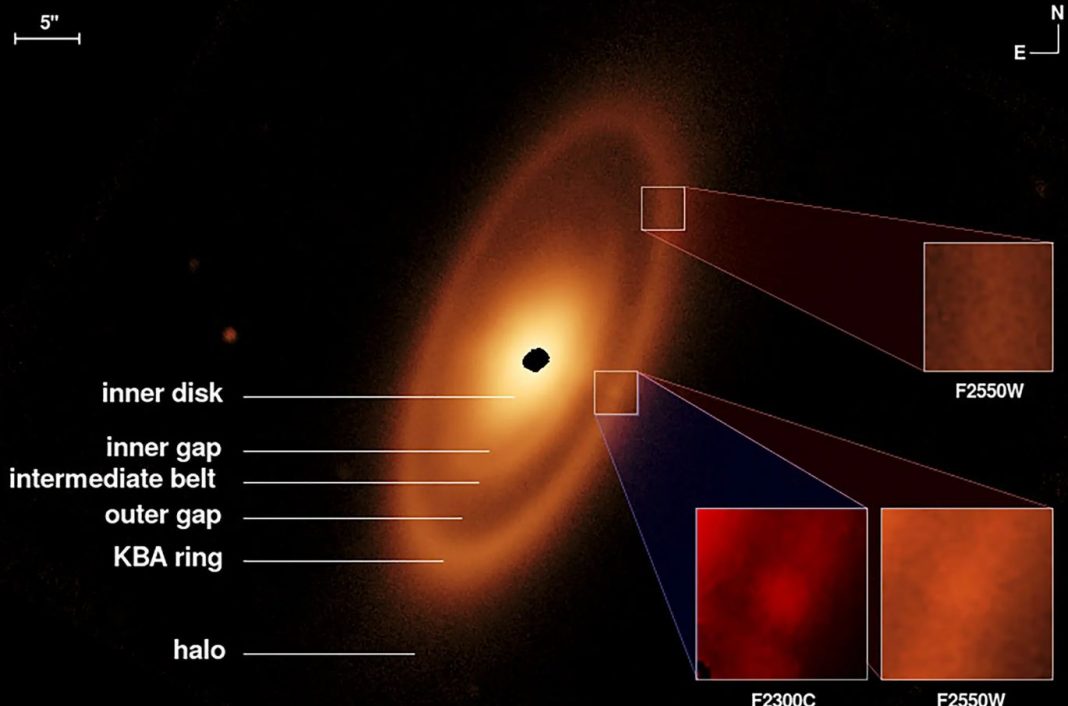Fomalhaut is a 25 light-year-away star that is so incredibly brilliant that it completely drowns out the light from the surrounding stars. For millennia, the mysteries of the cosmos have captivated onlookers.
Evidence that Fomalhaut is a dynamic star encircled in cosmic turmoil has now been established with the aid of the James Webb Space Telescope. Thanks to the observatory’s superior infrared vision, scientists are learning more about Fomalhaut’s peculiar properties, such as its peculiar, solar-system-unique ring.
The results could help us figure out how unusual or commonplace our solar system really is. “It’s hard to draw conclusions about if we’re common or not,” said Jessie Christiansen, the project scientist at NASA’s Exoplanet Archive who was not involved in the current research.
When compared to our sun, which is 4.6 billion years old, this star is relatively young, at 440 million years. However, stars like Fomalhaut have a limited lifespan of just a billion years. That puts it about in the middle of its stellar lifetime, paralleling that of the sun.
The sun has yet to exhibit symptoms of a midlife crisis, which is good news for all life in our galaxy. Larger objects, with the exception of the rare asteroid or comet collision, tend to stay inside their designated orbits. The eight planets formed long ago from the cloud of debris that surrounds newborn stars, with the primary areas of cosmic wreckage now being the stony asteroid belt between and Kuiper belt beyond Neptune.
Fomalhaut provides a more carefree perspective on midlife and stands in stark contrast to the tidy planets in our solar system. However, astronomical efforts to make sense of the star’s dispersed surrounds have only lately caught up with technological advancements.
Dr. Gaspar and his colleagues directed Webb’s Mid-Infrared Instrument towards Fomalhaut for the new investigation. Webb, which is more sensitive to infrared light than any previous space or ground observatory, has uncovered not one but three nested rings of wreckage encircling Fomalhaut.
The inner ring is like our asteroid belt, while the outer ring is like the Kuiper belt around the sun. Fomalhaut, however, also has an intermediary debris highway between the two, which is likely composed of a combination of ice and rocky detritus.
Planetary erosion may be responsible for the separation of Fomalhaut’s inner and intermediate rings. However, there was no visible proof that other planets exist. Only one planet, far larger than Jupiter, would still be warm enough for the Webb’s infrared sensor to pick up at this stage in Fomalhaut’s life cycle.
Fomalhaut b, a planet discovered by exoplanet hunters, was formerly assumed to be located in the intermediate belt. In 2020, however, Dr. Gaspar and his colleagues argued that the growing cloud of debris left behind by an epic collision was really an intact exoplanet all along.
The theory ran into trouble since it seemed that there was nothing here, making it implausible that two things had collided. With their finding of the intermediate debris belt, the team has provided a potential answer.
Dr. Christiansen of the NASA archive said, “We now know there’s stuff there.” Well, it seems like we have ourselves a collision, so that’s that.
Terrifically violent conflicts are occurring far from the star as well. It is possible that the massive dust storm seen in the outer asteroid belt is the afterimage of a previously unknown, enormous collision.
“That’s just cool,” Dr. Christensen said. What is it?” It’s a great tease.
The Webb telescope gives astronomers a front-row seat to the drama unfolding on this star, and they couldn’t be more excited. They learn to appreciate the peacefulness of the solar system as a result. The doctor then said, “If there are planets there, they’re getting smacked around by asteroids all the time.” This makes Fomalhaut seem “chaotic as hell,” which is exactly what Dr. Macintosh indicated it would be.

